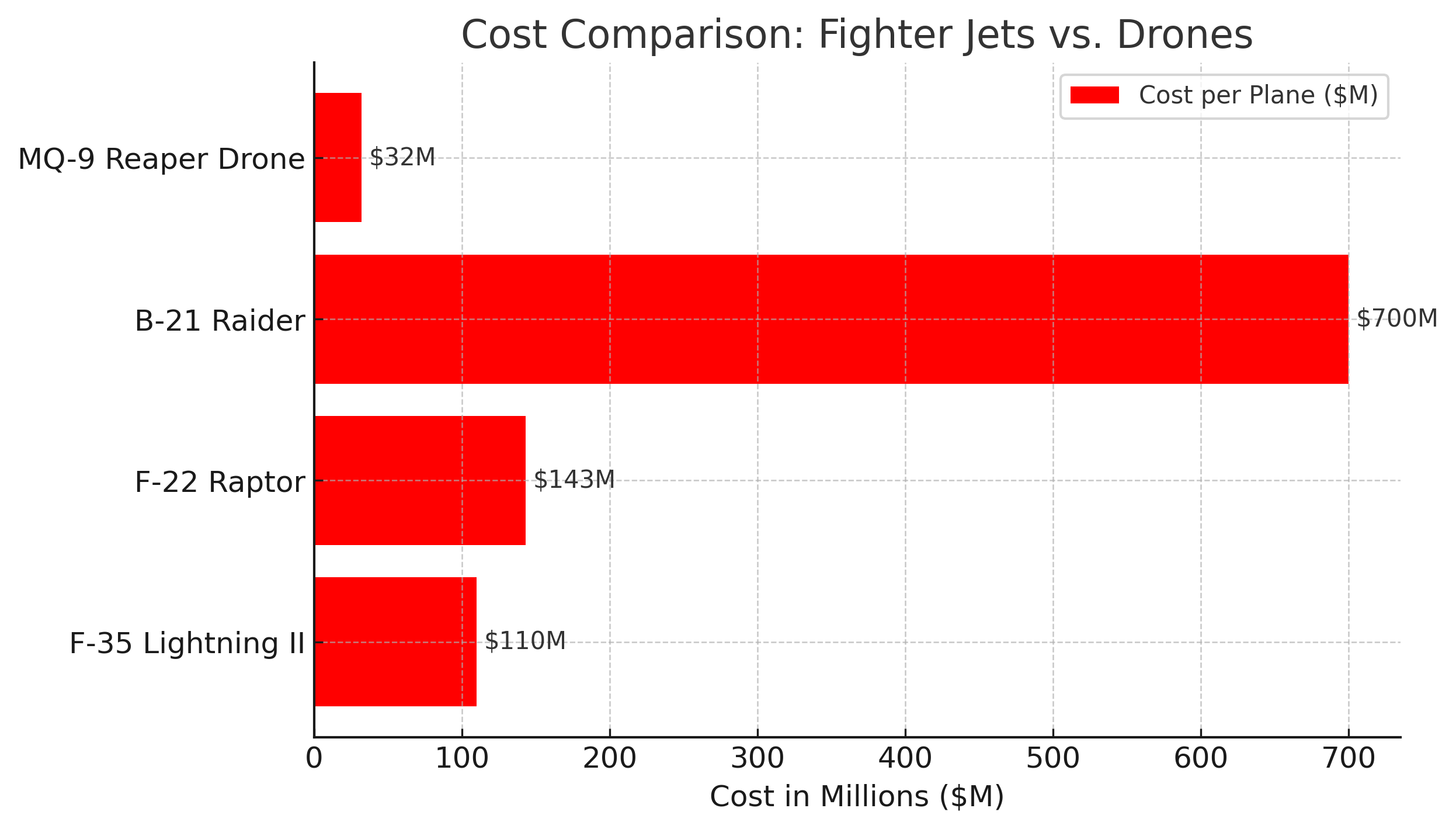One Simple Cut: How to Save Billions Without the Usual Politics
We can argue all day about military spending, but let’s cut through the noise and focus on one simple, realistic change: stop throwing billions at outdated fighter jets we don’t need, because drones are the future. This isn’t about gutting national defense—it’s about common sense. The F-35 is a disaster, the F-22 is obsolete, and the B-21 is a relic of a war we’re not fighting. Instead of wasting taxpayer dollars on machines that sit in hangars, let’s put that money where it actually matters—modern defense, veterans’ healthcare, or literally anything else useful. This post isn’t just a rant—it’s an action plan. One cut, big savings, no partisan nonsense. Let’s get it done.
The Fighter Jet Money Pit: Where Billions Go to Die
Step 1: Targeting the Biggest Budget Drains
Some fighter jets cost more to maintain than they’re worth in combat. By cutting just a few of these outdated, overpriced programs, we could save billions and invest in modern defense, cybersecurity, and veterans’ care. Here’s where the biggest waste happens:
Planes That Bleed Taxpayer Dollars
🛑 F-35 Lightning II (Joint Strike Fighter)
- 💰 $110 million per plane
- 💸 $1.7 trillion total program cost (biggest defense money pit ever)
- 🏗 $7.8 million/year per plane just for maintenance
- 🚨 Reality check: Constant mechanical failures, cost overruns, and drones often beat it in combat tests.
🛑 F-22 Raptor
- 💰 $143 million per plane
- 💸 $67 billion total program cost
- 🏗 $10 million/year maintenance per plane
- 🚨 Reality check: Only 186 ever built, hardly used in real-world combat, but still draining defense budgets.
🛑 B-21 Raider (Future Bomber)
- 💰 $700 million per plane (yes, per plane)
- 💸 $203 billion total fleet cost
- 🚨 Reality check: A nuclear bomber in an era where modern warfare is fought with cyber attacks and drones.

One Simple Fix: Cut These, Fund What Actually Matters
Instead of pouring billions into war machines better suited for the Cold War, we could save a trillion dollars, by cutting one thing we can all agree on. Let’s make it happen. 🚀
Step 3: Build a Coalition of Supporters
This proposal has bipartisan appeal because it aligns with fiscal conservatism (cutting wasteful spending) and progressive priorities (reducing military bloat and reallocating funds to social programs). Past surveys suggest around 60-70% of Americans support cutting costs on unnecessary defense programs
We need a mix of celebrities, experts, veterans, and influencers to push this message.
Celebrities Who Could Endorse It
- Mark Ruffalo – Strong advocate for cutting military spending.
- John Oliver – Could do a segment on wasteful defense spending (F-35 has been mocked before).
- AOC (Alexandria Ocasio-Cortez) – Supports budget cuts in military bloat.
- Tulsi Gabbard – Former military, outspoken on unnecessary wars.
- Hasan Minhaj – Could use a comedy/news format to break down the absurd costs.
Military & Policy Experts
- Andrew Cockburn (journalist, author of The Spoils of War) – Writes on Pentagon waste.
- Dan Grazier (Project on Government Oversight – POGO) – Military reform advocate.
- Lawrence Wilkerson (Retired Colonel, Former Chief of Staff to Colin Powell) – Critic of excessive defense spending.
Step 4: Direct Action & Advertising Plan
- Viral Video & Infographics Campaign
- Social media ads with shock-factor numbers (e.g., “F-35: $1.7 Trillion = Free College for Every American for X Years”).
- Videos comparing F-35 vs. drones, showing that one F-35 could buy 10+ Reaper drones.
- Petition to Congress
- Create an online petition targeting specific lawmakers on the House Armed Services Committee (which approves defense budgets).
- Use MoveOn.org, Change.org, or WhiteHouse.gov petitions.
- Target Defense Contractors & Expose Lobbying
- Highlight how Lockheed Martin (F-35), Northrop Grumman (B-21), and Boeing (F-22) profit from war while draining taxpayer funds.
- Push for defense budget transparency.
- Town Halls & Debates
- Organize debates between military reformers and defense industry reps.
- Get veterans involved to push back against Pentagon waste.
Step 5: Political Leverage – How Do We Get Congress to Act?
- Primary Challenges
- Identify politicians backed by defense contractors and support their challengers.
- Amendments to the NDAA (Defense Budget)
- Push progressive lawmakers (like AOC, Bernie Sanders) to introduce amendments cutting jet funding in the National Defense Authorization Act (NDAA).
- Redirect Savings
- Propose bills to reallocate fighter jet funding toward:
- Veterans’ healthcare
- Renewable energy R&D
- STEM education funding
- Propose bills to reallocate fighter jet funding toward:
Step 6: Expected Pushback & Counterarguments
- “We Need Fighter Jets for National Security”
- Response: Most modern threats (cyber warfare, terrorism, drone warfare) aren’t countered with billion-dollar jets.
- “Cutting Funding Hurts Military Jobs”
- Response: We can redirect funds to high-tech jobs in AI, drones, and cybersecurity, keeping employment inside the defense industry.
- “Drones Can’t Do Everything”
- Response: Even Air Force Generals admit that autonomous drones are the future, and legacy jets are outdated.


0 Comments